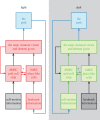Independence of landmark and self-motion-guided navigation: a different role for grid cells
- PMID: 24366147
- PMCID: PMC3866457
- DOI: 10.1098/rstb.2013.0370
Independence of landmark and self-motion-guided navigation: a different role for grid cells
Abstract
Recent interest in the neural bases of spatial navigation stems from the discovery of neuronal populations with strong, specific spatial signals. The regular firing field arrays of medial entorhinal grid cells suggest that they may provide place cells with distance information extracted from the animal's self-motion, a notion we critically review by citing new contrary evidence. Next, we question the idea that grid cells provide a rigid distance metric. We also discuss evidence that normal navigation is possible using only landmarks, without self-motion signals. We then propose a model that supposes that information flow in the navigational system changes between light and dark conditions. We assume that the true map-like representation is hippocampal and argue that grid cells have a crucial navigational role only in the dark. In this view, their activity in the light is predominantly shaped by landmarks rather than self-motion information, and so follows place cell activity; in the dark, their activity is determined by self-motion cues and controls place cell activity. A corollary is that place cell activity in the light depends on non-grid cells in ventral medial entorhinal cortex. We conclude that analysing navigational system changes between landmark and no-landmark conditions will reveal key functional properties.
Keywords: entorhinal cortex; grid cells; navigation; place cells.
Figures

References
-
- O'Keefe J, Nadel L. 1978. Hippocampus as a cognitive map. Oxford, UK: Clarendon.
Publication types
MeSH terms
LinkOut - more resources
Full Text Sources
Other Literature Sources

